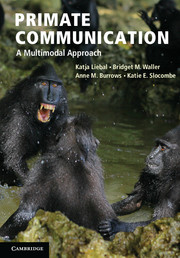Book contents
- Frontmatter
- Contents
- Preface
- Acknowledgements
- Part I Introduction to primate communication
- Part II Approaches to primate communication
- 4 The methods used in primate communication
- 5 A multimodal approach to primate communication1
- Part III Cognitive characteristics of primate communication
- Part IV Approaches to the evolution of primate communication
- Glossary
- References
- Species index
- Subject index
4 - The methods used in primate communication
Published online by Cambridge University Press: 05 December 2013
- Frontmatter
- Contents
- Preface
- Acknowledgements
- Part I Introduction to primate communication
- Part II Approaches to primate communication
- 4 The methods used in primate communication
- 5 A multimodal approach to primate communication1
- Part III Cognitive characteristics of primate communication
- Part IV Approaches to the evolution of primate communication
- Glossary
- References
- Species index
- Subject index
Summary
Primate communication tends to be divided into four different modalities of behavioural communication – olfactory communication, gesture, facial expression and vocalization – which span four different sensory channels (olfaction, vision, touch and audition). We use the term modality to refer to each type of behavioural communication in this way, but others have used modality to refer specifically to the sensory mode of the stimulus (e.g. Partan and Marler, 1999). We use our broader definition of modality for three reasons. First, one of our aims is to review and examine the classic scientific distinctions made between communicative domains. Second, some types of communication can use more than one sense: for example, gesture can be visual, tactile or auditory. Third, different cognitive mechanisms are thought to underlie both the production and perception of facial expressions, vocalizations, manual gestures and olfactory signals, and so treating them as different modes might be most productive for our purpose.
The aim of this chapter is not to provide a review of what is known about each modality, but instead to give an overview of the methods and general approaches employed. What follows is an outline of the scientific questions, methods for data collection and approaches to analysis within each area of primate communication research. For each modality, there is a section that refers to the brain mechanisms underlying its production and perception. However, it is important to emphasize that the focus here is on the main methods used to study the neural correlates of primate communication, while Chapter 3 discusses the corresponding brain areas and neural circuits in more detail. Importantly, it will soon become clear that the methods (and perhaps more importantly, the scientific questions) can differ between modalities.
- Type
- Chapter
- Information
- Primate CommunicationA Multimodal Approach, pp. 73 - 103Publisher: Cambridge University PressPrint publication year: 2013



